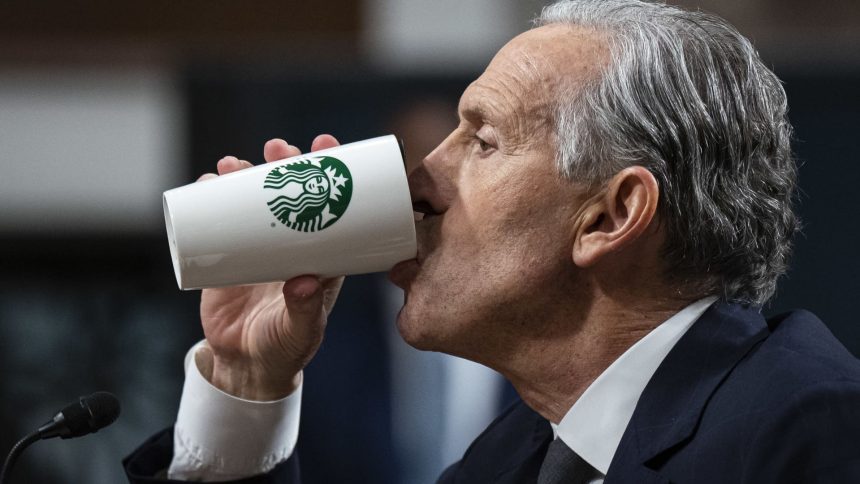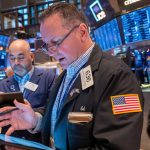When a company performs well and I interview its CEO on CNBC, I consider the stock’s performance before fashioning my questions. When a chief executive is hitting it out of the park, the interview is going to be easy. My main objective is to find out if the great numbers are sustainable. Is there something special about the business model or the product? Maybe the company had been poorly run and the guest is a new CEO who is turning it around. Maybe the company offers something truly different that makes it stand out. Or maybe he or she is just lucky. Whatever the reason, it’s unlikely to be a hard-hitting discussion because there is nothing to hit hard. These interviews are mainly informative. On Friday, for example, I chatted with Albert Manifold, the CEO of CRH , the largest construction country in the United States. In fact, CRH is bigger than the next three U.S. construction companies combined, even as it is based in Dublin, Ireland, and has led construction in Europe for many years. Its stock has also way outperformed its peers the last six months. It turns out that CRH offers a turnkey approach that its clients — the road builders flush with capital from the Inflation Reduction Act and the electric utilities building out their plants to meet data center demand — seem to love. Why? Because CRH can come in below the cost of its competitors and still do the jobs as well or better, according to Manifold. Who am I to disagree? I wasn’t out to bag the CEO. Rather, I wanted to find out what inning we’re in of the infrastructure boom. I came away thinking we are so early that, despite the stock’s move to $83 from $48 in the last year, including a big $3-plus jump after it reported earnings Thursday — there’s a lot still left in the tank. I was impressed that you could still buy this stock and do well. Was it easy to do that interview? My staff and I probably spent ten hours learning the story and coming up with the questions that, when answered clearly, will help me reach a conclusion. That’s just part of the job and I like it — always have and hopefully always will. In the business, I am what’s known as a generalist analyst. I must be able to cover any stock from any industry. Right after CRH, I interviewed the CEO of Recursion Pharmaceuticals , a small and profitless company that uses generative AI to discover new drugs for hard-to-solve illnesses. This is an area conventional drugmakers don’t want to get into because it is too costly and can often fail. But CEO Chris Gibson has an advantage: the backing of Nvidia ‘s CEO Jensen Huang, who wants to shorten the time it takes to make drugs. Huang told me about the company so I looked into it and had my staff to book him. After studying Recursion and interviewing Gibson, I concluded this could be an ideal company for a very young investor — one with plenty of time to wait and take bigger chances. Recursion is a hit-or-miss situation. The challenges are so great and the chances of failure — even with Nvidia’s new AI chips — are incredibly high. But if the company discovers a winning drug, it will be bought by a bigger drugmaker or make it all on its own. My only reservation is that Recursion’s largest shareholder is ARK Invest, the investment firm run by Cathie Wood. I don’t care for Wood’s style because it is doctrinaire and there’s no room for doctrinaire in this business. Once Wood picks a stock, that company can do no wrong, which is code for she can do no wrong. In life and stock picking, that’s an ill-advised attitude. That aside, Recursion is intriguing but not a short-term play. It needs a breakthrough to make it work now. Maybe the company has one, but it wasn’t yet evident. The big issue right now for analysts and journalists is to figure out if the strong U.S. consumer is getting weaker. So I am naturally drawn to having CEOs who can help answer that question. After all, if we are going to get interest rate cuts, central to stock picking at this moment, we need to see weakness in the consumer. We need to see a strapped consumer worried about inflation. According to a recent Gallup poll, 55% of Americans are worried about inflation, making it the single biggest worry. And if they’re worried about inflation, pocketbooks are front and center. It therefore stands to reason that the customer will gravitate toward companies that offer the most value. I am currently testing that thesis with my CEO interviews. Sure enough, when I examine the restaurant chains, the biggest winners are the companies that offer the most value. That includes the “3 for Me” menu at Chili’s, owned by Brinker , the $11.00 early bird steak from Texas Roadhouse , an inexpensive Domino’s pizza, or a box of wings from Wingstop . Not surprisingly, those restaurants have stocks that are killing it. If you are worried about inflation you aren’t going premium. Top-line items were so in fashion before Covid and even at home during the pandemic. But now premiumization appears to be dead. People are going discount. They want deals. Inflationary worries, for instance, are dinging the stock of Darden because its Olive Garden chain has gotten relatively expensive. The stock of liquor company Diageo , where the liquor premiumization strategy had been heavily embraced, has fizzled. Way too much price taken. Of course, there are exceptions. Chipotle put through small price increases, but the Mexican food chain offers relative value because it is perceived as fresher, bigger, and better than others in the space. I interview Chipotle execs almost every quarter and I agree with that assessment. Chipotle’s product is just too good to say no to. And take it from me, an old Mexican restaurant veteran, it travels better than any other restaurant chain. Yum! Brands , on the other hand, which has KFC, Taco Bell, and Pizza Hut, isn’t considered a relative value, although Taco Bell offers some absolute bargains. But Pizza Hut is viewed as a suspect brand and KFC is all over the place. Nobody I know goes to Yum restaurants for a healthy meal. That’s probably a big reason why the stock has been disappointing. Chipotle’s stock is up 41% this year. Yum is up 5%. If you work backward — look at the stock action and then figure out why it happened — you conclude that value is winning. The stock with the best value, relative or absolute, is on top. Chili’s $10.99 Big Smasher burger is a huge draw. Texas Roadhouse’s early bird steak must be integral to the performance of the company’s stock. Shares of Brinker are up nearly 39.8% this year, while shares of Texas Roadhouse are up 40.2%. This brings me to the outliers in the restaurant industry: McDonald’s and Starbucks . McDonald’s stock was up $7 on Friday. Why? Because the company has heard the customer opprobrium. The fast-food chain has been raising prices with impunity for ages. It has gone from a bargain to a relative bargain to relatively expensive. Management recognizes that it has priced out consumers and is reportedly working on a $5 value meal . That’s why its stock was up. It will be up again when more information on the deal is revealed. McDonald’s realized it must be an inflation fighter to get back in the game. The stock says so, too. That concept sends me to one of my great misjudgments of the year in Starbucks. When we bought the coffee chain giant, I thought it offered worldwide relative value. But unlike Chipotle, the value was going unrecognized. The stock had been down, and yet the brand seemed unassailable and the management team was hard-working and brilliant. I figured that CEO Laxman Narasimhan would come up with solutions to the company’s problems and the stock would recover and flourish. Sure, there are boycott issues involving the Middle East and Starbucks, even though Starbucks has no connection with Israel. For a long time, it did have a Jewish leader in former CEO Howard Schultz. And we do have social media in this country that has at times incited intimidating protests. They have undeniably torched the stock. Believe me, we thought about kicking it out of the portfolio because of these protests. But we figured that the furor would die down or be controlled. Despite the protests, with a damage that could not be quantified and would not be quantified by management, the stock was just too cheap versus its cash flow, earnings and reputation. We all know by now how that all turned out. The company last month reported simply disastrous same-store sales, down 4% when analysts were looking for a 1.5% gain. And it earned 68 cents for the quarter when the Street was looking for 80 cents. I have always used a 5% rule. If you think that you are going to miss by 5% you should pre-announce results. Starbucks missed by a heck of a lot more than 5% but did not preannounce, which is shocking in itself. But let’s get at the perception of Starbucks. I see the issues — when it comes to the stock’s sellers — as three-fold: the lines are too long, especially when people who use mobile order seem to cut ahead, the drinks are too complex to the point that the baristas can’t make them fast enough and sometimes can’t make them at all, and the prices are too high. Now, remember, this is all about perception. Maybe the throughput — the time to get through the store — is better than ever. Maybe its drinks aren’t too complex; there are only issues with the stores I go to. Maybe it’s cheap, as cheap as Dutch Bros , even as a head-to-head comparison shows Dutch Bros as cheaper on every count. At times, Starbucks has offered inexpensive specials, but they are one off and not obvious. Other times loyalty members may be getting deals although I don’t think they are easy to see. Why Starbucks had such awful numbers last quarter comes down to these three issues. But in my painful interview with Narasimhan, I felt that none of those issues were in play at all. In fact, I didn’t even get a sense from Narasimhan that those numbers were all that bad. In the post-earnings conference call with investors, Narasimhan said weather negatively impacted the company’s performance. But I had the head-to-head comps from other chains that didn’t have any weather negativity at all. Very strange. I felt almost illegitimate in my questioning about how the company was doing. Yet I felt it was pretty natural to ask, given that my Charitable Trust is being crushed by the stock’s performance in a decidedly up year. A truth, and reconciliation with that truth, is always helpful when you are on TV talking about a stock that has annihilated investors’ portfolios. I did a lot of self-remonstration about owning Starbucks after that interview. To say the least. Remember my rule: a pick that costs me money is not the fault of the CEO. It’s my fault. I should have known better than to own the stock. I should have done enough work to know that the CEO was not delivering performance and I should have sold it. I knew it would be a bad quarter, I told you it would be a bad quarter. But I never in a million years would have believed it could be that bad. Or that the CEO would seem glib about a plan to turn things around. It seemed a bigger deal to me than to him. Suboptimal. If the CEO was doing a great job but the stock was going down anyway, I have to deal with that. If that’s the case, I am a buyer. But that’s not the case. To tell viewers and readers that the CEO is doing a great job and the chain is hitting on all cylinders would be delusional. So why own it still? A few reasons. One is activism, something this industry is prone to. Why not go after Starbucks, given the brand is so sensational? We can only conclude that someone with a ton of capital might think that there are better ways to fix the company. You might wait around to see what happens. Two is that Howard Schultz might cause such a commotion that it causes a greater sense of urgency. Forgive me if there is a sense of urgency because I don’t see it. But the biggest reason you would hold on to Starbucks is an obvious one: The company could switch stripes and offer a cheap, good, fast cup of coffee. An inflation-busting cup of Joe, like McDonald’s is doing with its value meal. I was shocked that Narasimhan indicated one of the ways to make the chain better was to develop an even more complex offering. Ugh. As a beleaguered customer, I would say that’s the last thing that’s needed. It does seem pretty obvious after the burst of buying of McDonald’s stock on even the talk of a cheaper meal: A dramatically cheaper offering (or offerings) at Starbucks might be the solution. I didn’t get the impression that such a move is in the cards after interviewing Narasimhan. A cheaper cup of coffee would propel the stock instantly because buyers would rush in expecting a change in the comps almost immediately. That’s provided the baristas could handle the traffic onslaught. To go full circle: It should be obvious to every CEO that the winners in the restaurant space are those that are fighting inflation with inexpensive and tasty offerings. The losers are the ones that aren’t and regard this moment as business as usual. You want your stock to go up? Offer a bargain that consumers who are worried about inflation would be thrilled to buy. It’s a simple fix that’s downright empirical when you look at the winners and losers in the space. If you ask me which businesses have staying power right now, it’s the chains with CEOs who understand what consumers want: a deal. Those that aren’t cutting it? Those are the ones who can’t fight the perception that they aren’t offering a bargain or even a relative bargain. The good news? CEOs can figure this out. The bad news, at least for my trust? Starbucks hasn’t figured it out. Until then, no matter what the CEO says, this stock will struggle to go higher and it will remain in the big loser column of the portfolio, along with Foot Locker . I didn’t realize how palpable and cogent this pricing dilemma was when we bought the stock of Starbucks. There is still hope. How about offering a coffee for under $2 for any loyalty member? Separate line. Super fast service. You do that, you have a $100 stock even if you lose money on that low-price option — although I bet that wouldn’t happen because customers would buy other goods and because the demand would soar. One more thought: I don’t know coffee enough to figure out if the everyday low price coffee can be good tasting. But I know stocks. I urged McDonald’s to do a rollback. It’s already working and they haven’t even announced it yet. I am asking, right here, for Starbucks to do a rollback, an inflation buster. The stock will become a must own. Otherwise? We should have just bought Dutch Bros. (See here for a full list of the stocks in Jim Cramer’s Charitable Trust.) As a subscriber to the CNBC Investing Club with Jim Cramer, you will receive a trade alert before Jim makes a trade. Jim waits 45 minutes after sending a trade alert before buying or selling a stock in his charitable trust’s portfolio. If Jim has talked about a stock on CNBC TV, he waits 72 hours after issuing the trade alert before executing the trade. THE ABOVE INVESTING CLUB INFORMATION IS SUBJECT TO OUR TERMS AND CONDITIONS AND PRIVACY POLICY , TOGETHER WITH OUR DISCLAIMER . NO FIDUCIARY OBLIGATION OR DUTY EXISTS, OR IS CREATED, BY VIRTUE OF YOUR RECEIPT OF ANY INFORMATION PROVIDED IN CONNECTION WITH THE INVESTING CLUB. NO SPECIFIC OUTCOME OR PROFIT IS GUARANTEED.
When a company performs well and I interview its CEO on CNBC, I consider the stock’s performance before fashioning my questions. When a chief executive is hitting it out of the park, the interview is going to be easy. My main objective is to find out if the great numbers are sustainable. Is there something special about the business model or the product? Maybe the company had been poorly run and the guest is a new CEO who is turning it around. Maybe the company offers something truly different that makes it stand out. Or maybe he or she is just lucky.
Read the full article here
News Room




